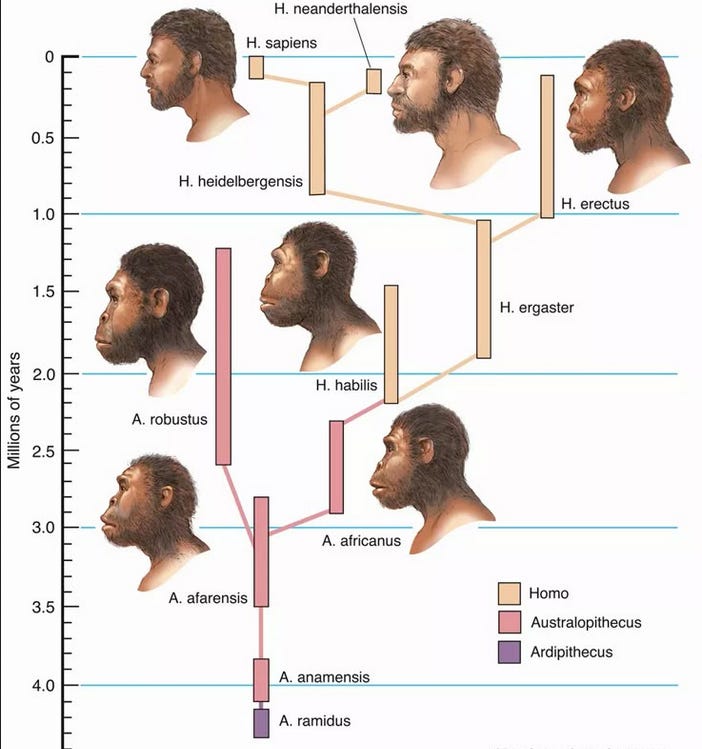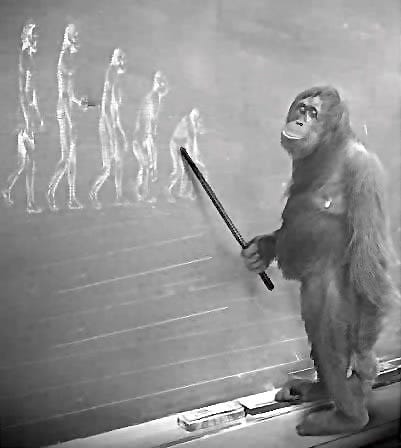The evolutionary doctrine holds that modern man evolved from some kind of apelike creature. During this alleged evolutionary process, which is supposed to have started from 5 to 6 million years ago, it is claimed that there existed transitional forms between modern man and his ancestors. The theory of evolution is based on the hypothesis that the contemporary man of today has evolved from its primate (ape) ancestors.
According to this completely imaginary scenario, the following five basic categories are listed:
australopithecines (Australopithecus) or “South African ape”
H. habilis or “tool using man”
H. erectus or “upright walking man”
archaic H. sapiens or “old modern man”
H. sapiens sapiens or “modern man”
Evolutionists call the genus to which the alleged apelike ancestors of man belonged Australopithecus, which means “southern ape.” Australopithecus, which is nothing but an old type of ape that has become extinct, is found in various forms. Some of them are larger and more strongly built (robust), while others are smaller and more delicate (gracile).
The next step in the imaginary human evolution is Homo, that is, the human series. These living beings are humans who are no different from modern men, yet who have some racial differences. Seeking to exaggerate these differences, evolutionists represent these people not as a “race” of modern man but as a different “species.”
However, as we will soon see, the people in the Homo series are nothing but ordinary human racial types. According to the evolutionist claims, the living things in the Homo series are more developed than Australopithecus, and not very different from modern man.
The modern man of our day, that is, the species H. sapiens, is said to have formed at the latest stage of the evolution of this genus Homo. Fossils like “Java man,” “Peking man,” and “Lucy” appear in the media from time to time. They are included in one of the five groups listed above. Each of these groupings is also assumed to branch into species and subspecies, as the case may be. Some suggested transitional forms of the past, such as Ramapithecus, had to be excluded from the imaginary human family tree after it was realized that they were ordinary apes.1
By outlining the links in the chain as “australopithecines > H. habilis > H. erectus > H. sapiens,” the evolutionists imply that each of these types is the ancestor of the next. However, recent findings by paleoanthropologists have revealed that australopithecines, H. habilis, and H. erectus existed in different parts of the world at the same time. Moreover, some of those humans classified as H. erectus probably lived up until very modern times.
In an article titled “Latest Homo erectus of Java: Potential Contemporaneity with Homo sapiens in Southeast Asia,” it was reported that H. erectus fossils found in Java had “mean ages of 27 ± 2 to 53.3 ± 4 thousand years ago” and this “raise[s] the possibility that H. erectus overlapped in time with anatomically modern humans (H. sapiens) in Southeast Asia.”2 Furthermore, H. sapiens neanderthalensis (Neanderthal man) and H. sapiens sapiens (modern man) also clearly coexisted. This situation apparently indicates the invalidity of the claim that one is the ancestor of the other.
Intrinsically, all the findings and scientific research have revealed that the fossil record does not suggest an evolutionary process as evolutionists propose. The fossils which evolutionists claim are the ancestors of humans in fact belong to either different human races, or species of ape. Then which fossils are human and which ones are apes? Is it ever possible for any one of them to be considered a transitional form?
In order to find the answers, let us have a closer look at each category. The scenario of human evolution is complete fiction. In order for such a family tree to represent the truth, a gradual evolution from ape to man must have taken place and a fossil record of this process should be able to be found. In fact, however, there is a huge gap between apes and humans. Skeletal structures, cranial capacities, and such criteria as walking upright or bent sharply forward distinguish humans from apes.
Another significant finding proving there can be no family–tree relationship among these different species is that species presented as ancestors of others in fact lived concurrently. If as evolutionists claim, Australopithecus changed into H. habilis, which, in turn, became H. erectus, the periods they lived in should necessarily have followed each other. However, there is no such chronological order to be seen in the fossil record.
According to evolutionist estimates, Australopithecus lived from 4 million up until 1 million years ago. The creatures classified as H. habilis, on the other hand, are thought to have lived until 1.7 to 1.9 million years ago. H. rudolfensis, which is said to have been more advanced than H. habilis, is known to be as old as 2.5 to 2.8 million years! That is to say, H. rudolfensis is nearly 1 million years older than H. habilis, of which it is alleged to have been the ancestor.
On the other hand, the age of H. erectus supposedly goes as far back as 1.6 to 1.8 million years ago, which means that H. erectus appeared on the Earth in the same time frame as its so–called ancestor, H. habilis.
Evolutionist Alan Walker confirms this by stating that,
“there is evidence from East Africa for late–surviving small Australopithecus individuals that were contemporaneous first with H. Habilis, then with H. erectus.”3
Louis Leakey found fossils of Australopithecus, H. habilis, and H. erectus almost next to each other in the Olduvai Gorge region of Tanzania, in the Bed II layer.4
But there is definitely no such family tree. Stephen Jay Gould, the paleontologist from Harvard University, explains this deadlock faced by evolution although he is an evolutionist himself:
“What has become of our ladder if there are three coexisting lineages of hominids (A. africanus, the robust australopithecines, and H. habilis), none clearly derived from another? Moreover, none of the three display any evolutionary trends during their tenure on earth.”5
When we move on from H. erectus to H. sapiens, we again see that there is no family tree to talk about. There is no evidence showing that H. erectus and archaic H. sapiens continued living up to 27,000 years and even as recently as 10,000 years before our time. In the Kow Swamp in Australia, some 13,000–year–old H. erectus skulls have been found. On the island of Java, H. erectus remains were found that are 27,000 years old.6 One of the most surprising discoveries in this area was the supposed 30,000–year–old H. erectus, Neanderthal, and H. sapiens fossils found in Java in 1996.
The New York Times wrote in its cover story: “Until about a couple of decades ago, scientists conceived of the human lineage as a neat progression of one species to the next and generally thought it impossible that two species could have overlapped in place or time.”7
This discovery reveals once again the invalidity of the evolutionary tree scenario regarding the origin of man. The concept that we are just animals, only slightly removed from apes, means that there are no moral standards, no laws worth obeying, no future, and no hope. The realization of this terrible truth even penetrated the gloom of Darwin’s mind at times.
“With me the horrid doubt always arises whether the convictions of man’s mind, which has been developed from the minds of the lower animals, are of any value or at all trustworthy. Would anyone trust in the convictions of a monkey’s mind, if there are any convictions in such a mind?”8
Most all of these supposed ancestral bones of man have been catalogued in a Time–Life book, The Missing Link, Volume 2 in the “Emergence of Man Series,” published in 1972. It has a complete listing of all the australopithecine finds up to the end of 1971.
Although over 1,400 specimens are given, most are little more than scraps of bone or isolated teeth. Not one complete skeleton of one individual exists. All that anthropologists have in their ancestral closet are bits and pieces.
“The fossils that decorate our family tree are so scarce that there are still more scientists than specimens. The remarkable fact is that all the physical evidence we have for human evolution can still be placed, with room to spare, inside a single coffin!”9
“The entire hominid collection known today would barely cover a billiard table. . . . The collection is so tantalizingly incomplete, and the specimens themselves often so fragmentary and inconclusive, that more can be said about what is missing than about what is present.”10
“I don’t want to pour too much scorn on paleontologists, but if you were to spend your life picking up bones and finding little fragments of head and little fragments of jaw, there’s a very strong desire there to exaggerate the importance of those fragments.”11
“The problem with a lot of anthropologists is that they want so much to find a hominid that any scrap of bone becomes a hominid bone.”12
From grade school on up, children are taught about cavemen, and are gradually conditioned to the idea that we evolved from lower forms of life. They are also taught about the bones and skulls of our “ancestors.” As adults, we frequently hear reports of fossil remains of apelike humans that have been found. Each “discovery” has been hailed as a landmark proof of the theory of evolution. Scientists have given a name to these supposed half–man/half–ape remains; they call them hominids. But none of these hominids never existed. The evolutionary family tree has collapsed. When evolution is tested and held up to the light of God’s word, we see it for what it is- an empty theory that offers no hope, no future, and no answers.
PS. If you loved this article, be sure to check out our Ancient Pathways Patreon site with loads of content for free subscribers and exclusive content for members such as “Ancient Artwork”, the book “Giants: Against Evolution, and our “Out of Place Artifacts Digital Library” all available for download.
Recommended Reading:
Cuozzo, J. (1998). Buried alive: The Startling, Untold Story About Neanderthal Man. New Leaf Publishing Group.
DeYoung, D. (2005). Thousands. . . not billions: Challenging an Icon of Evolution - Questioning the Age of the Earth. New Leaf Publishing Group.
Geisler, N. L., & Turek, F. (2021). I Don’t Have Enough Faith to be an Atheist. Crossway.
Jeanson, N. (2022). Traced: Human DNA’s Big Surprise. New Leaf Publishing Group.
Lubenow, M. L. (2004). Bones of Contention: A Creationist Assessment of Human Fossils. Baker Books.
Martin, J., & Martin, J. R. (2004). The Evolution of a Creationist: A Laymen’s Guide to the Conflict Between the Bible and Evolutionary Theory. Exploration Films.
Rupe, C., & Sanford, J. (2017). Contested Bones.
Wells, J. (2002). Icons of Evolution: Science or Myth? Why Much of What We Teach About Evolution Is Wrong. Simon and Schuster.
Footnotes:
Pilbeam, David, “Rearranging Our Family Tree,” Human Nature, June 1978, p. 40.
Swisher, C. C., III, W. J. Rink, S. C. Antón, H. P. Schwarcz, G. H. Curtis, A. Suprijo, Widiasmoro, “Latest Homo erectus of Java: Potential Contemporaneity with Homo sapiens in Southeast Asia,” Science, Volume 274, Number 5294, Issue of 13 Dec 1996, pp. 1870–1874; also see, Jeffrey Kluger, “Not So Extinct After All: The Primitive Homo Erectus May Have Survived Long Enough To Coexist With Modern Humans,” Time, December 23, 1996.
Leakey, R., A. Walker, “On the Status of Australopithecus afarensis,” Science, vol. 207, issue 4435, 7 March 1980, p. 1103.
Kelso, A. J., Physical Antropology, 1st ed., J. B. Lipincott Co., New York, 1970, p. 221; M. D. Leakey, Olduvai Gorge, vol. 3, Cambridge University Press, Cambridge, 1971, p. 272.
Gould, S. J., Natural History, vol. 85, 1976, p. 30.
Kluger, Jeffrey, “Not So Extinct After All: The Primitive Homo erectus May Have Survived Long Enough to Coexist with Modern Humans,” Time, 23 December 1996.
Wilford, John Noble, “3 Human Species Coexisted Eons Ago, New Data Suggest,” New York Times, 13 December 1996.
Darwin, Charles, quoted in Francis Darwin (ed.), Life and Letters of Charles Darwin (1903; 1971 reprint), Vol. 1, p. 285.
Science Digest 90, May 1982, p. 44.
Reader, John, New Scientist 89, March 26, 1981, p. 802.
Kirby, Greg, address at meeting of Biology Teachers’ Association, South Australia, 1976 [Flinders University professor].
White, Timothy, quoted in New Scientist 98, April 28, 1983, p. 199 [University of California anthropologist].











The theory of evolution necessarily needs to make allowance for mutations. This includes mutations that may advance but not completely transform a species. Evolution well accounts for eyes adapting once introduced but struggles to explain incremental advancements as a pathway towards eyeballs. If mutations can turn a reptile into a bird, for instance, could a less extreme mutation turn a less advanced human into a more advanced human, but one that is still able to mate with the less advanced human?
Point being, if genetics operated this way, it would account for an advance occurring at a specific place. If an advanced group occurs with associated dominant genes, this could account for what would otherwise be a confusing combination of overlapping and mixing.
As it turns, The Urantia Book, published in 1955, affirms this perspective on evolutionary development. And it provides a detailed history of humanity's genetic mutations, evolution, and mixing over the last one million years.
In 1955, we were still trying to figure out how many chromosomes humans have. For almost twenty years, I have been documenting how new discoveries and scientific advances are increasingly verifying the book's account of planetary history. The field of genetics has been especially good for the credibility of the authors, which claim to be angelic, essentially--revelatory.
The short version is that the human genetic mutation (“Andonite”) occurred 1,000,000 years ago. The mutation did not produce sufficient intelligence for civilization to develop on a group level. But on an individual level, the mutation provided minimally sufficient intellectual advancement for the activation of true spiritual faithfulness. Another mutation occurred 500,000 years ago, near Afghanistan, giving rise to six colored races. To greater and lesser degrees, all of these races possessed sufficient intelligence for the development of civilization. Genetic changes occurred around 200,000 years ago and 37,000 years ago that do not summarize easily. But suffice it to say, they relate to the Nodites and Adamites, respectively. The mix of Nodite and Adamite is termed Andite. Nodite relates to our poorly preserved records of the Nephilim, who, during the times of Adam, had a cultural center known as the Land of Nod.
For a complete review of the subject see: Genetic Introductions, Mutations, and Evolution: a Urantia Book perspective. https://ubannotated.com/main-menu/animated/topical-studies/eugenics-and-race/genetic-mutation-evolution-urantia/